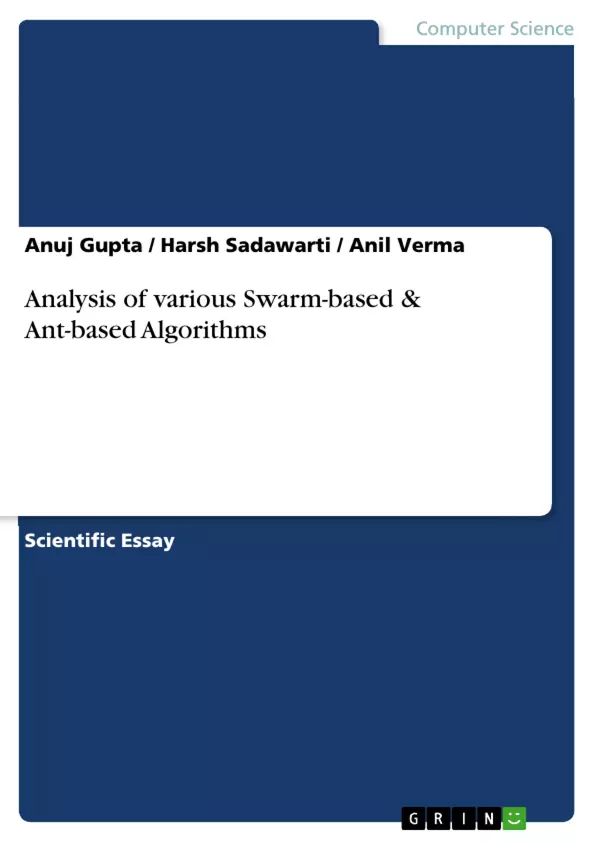Ant algorithms and swarm intelligence systems have been offered as a novel computational approach that replaces the traditional emphasis on control, preprogramming and centralization with designs featuring autonomy, emergence and distributed functioning. These designs provide scalable, flexible and robust, able to adapt quickly changes to changing environments and to continue functioning even when individual elements fail. These properties make swarm intelligence very attractive for mobile ad hoc networks. These algorithms also provide potential advantages for conventional routing algorithms. Ant Colony Optimization is popular among other Swarm Intelligence Techniques.In this paper a detailed comparison of different Ant based algorithms is presented. The comparative results will help the researchers to understand the basic differences among various existing Ant colony based routing algorithms.
Inhaltsverzeichnis (Table of Contents)
- Introduction
- Swarm Intelligence
- Ant Colony Optimization
- Ant Based Algorithms
- Flat Routing Algorithms
- AntNet
- ABC
- ARA
- AntHocNet
- Hierarchical Routing Algorithms
- MABR
- Probabilistic Emergent Routing Algorithm
- Flat Routing Algorithms
- Comparison of Ant Based Algorithms
- Parameters for Simulation
- Conclusion
- Future Work
- Acknowledgements
- References
Zielsetzung und Themenschwerpunkte (Objectives and Key Themes)
This paper aims to provide a detailed comparison of various existing ant-based routing algorithms used in mobile ad hoc networks (MANETs). By analyzing different approaches and their key characteristics, the paper aims to inform researchers on the strengths and weaknesses of each algorithm, facilitating the selection of suitable protocols for their research endeavors. Key themes explored in this paper include:- Ant Colony Optimization (ACO) as a routing strategy in MANETs
- Comparison of different ant-based algorithms (AntNet, ABC, ARA, AntHocNet, MABR, PERA) in terms of their structure, functionality, and performance
- The role of swarm intelligence in routing optimization for ad hoc networks
- Evaluation metrics for assessing the performance of ant-based routing algorithms
- Potential future research directions in the field of ant-based routing algorithms
Zusammenfassung der Kapitel (Chapter Summaries)
Introduction
This chapter introduces the concept of ad hoc networks and their unique characteristics, such as self-organization and dynamic topology. The limitations of traditional routing techniques in such environments are highlighted, emphasizing the need for specialized algorithms that adapt to frequent changes. The advantages of swarm intelligence, particularly ant colony optimization (ACO), for addressing these challenges are discussed.Swarm Intelligence
This chapter provides an overview of Swarm Intelligence (SI), a paradigm inspired by the collective intelligence of social insects. The chapter explores how SI leverages the emergent behavior of decentralized, self-organized systems to solve complex optimization problems. The concept of stigmergy, a form of indirect communication within ant colonies, is introduced as a key mechanism for guiding ant behavior.Ant Colony Optimization
This chapter focuses on Ant Colony Optimization (ACO), a popular swarm intelligence technique inspired by the foraging behavior of real ant colonies. The chapter explains how ants deposit pheromone on the ground to create trails, with shorter paths attracting more ants and becoming more reinforced. The chapter also highlights the two forms of solution evaluation employed by ants: explicit and implicit evaluation.Ant Based Algorithms
This chapter delves into various ant-based algorithms designed for solving routing problems in ad hoc networks. The algorithms are categorized into flat routing algorithms (AntNet, ABC, ARA, AntHocNet) and hierarchical routing algorithms (MABR, PERA). Each algorithm is discussed in detail, outlining its specific features, strengths, and weaknesses.Comparison of Ant Based Algorithms
This chapter presents a comparative analysis of the different ant-based routing algorithms discussed in the previous chapter. The algorithms are compared based on various parameters, including their ant structures, pheromone deposition mechanisms, and routing table structures. The chapter analyzes the trade-offs between different approaches in terms of cost, efficiency, and ability to explore new paths.Parameters for Simulation
This chapter focuses on the performance evaluation parameters used to assess the performance of ant-based routing algorithms in simulations. The chapter discusses two classes of metrics: scenario metrics and performance metrics. The chapter also provides a comprehensive list of qualitative and quantitative protocol features that contribute to a protocol's performance.Conclusion
This chapter summarizes the main findings of the paper, highlighting the strengths and weaknesses of different ant-based routing algorithms. The chapter emphasizes the need for further research to improve the performance and efficiency of these algorithms in real-world scenarios.Future Work
This chapter outlines potential future research directions for ant-based routing algorithms. The chapter suggests the need for further simulations and performance evaluations using the metrics discussed in the paper. The chapter also encourages researchers to explore new approaches to address the challenges associated with dynamic network topologies and resource constraints in MANETs.Schlüsselwörter (Keywords)
This paper delves into the application of swarm intelligence, particularly ant colony optimization (ACO), for addressing routing challenges in mobile ad hoc networks (MANETs). Key concepts explored include: ant-based algorithms, flat routing algorithms, hierarchical routing algorithms, pheromone deposition, routing table structures, performance evaluation metrics, and future research directions.- Quote paper
- Anuj Gupta (Author), Harsh Sadawarti (Author), Anil Verma (Author), 2011, Analysis of various Swarm-based & Ant-based Algorithms, Munich, GRIN Verlag, https://www.hausarbeiten.de/document/205047


